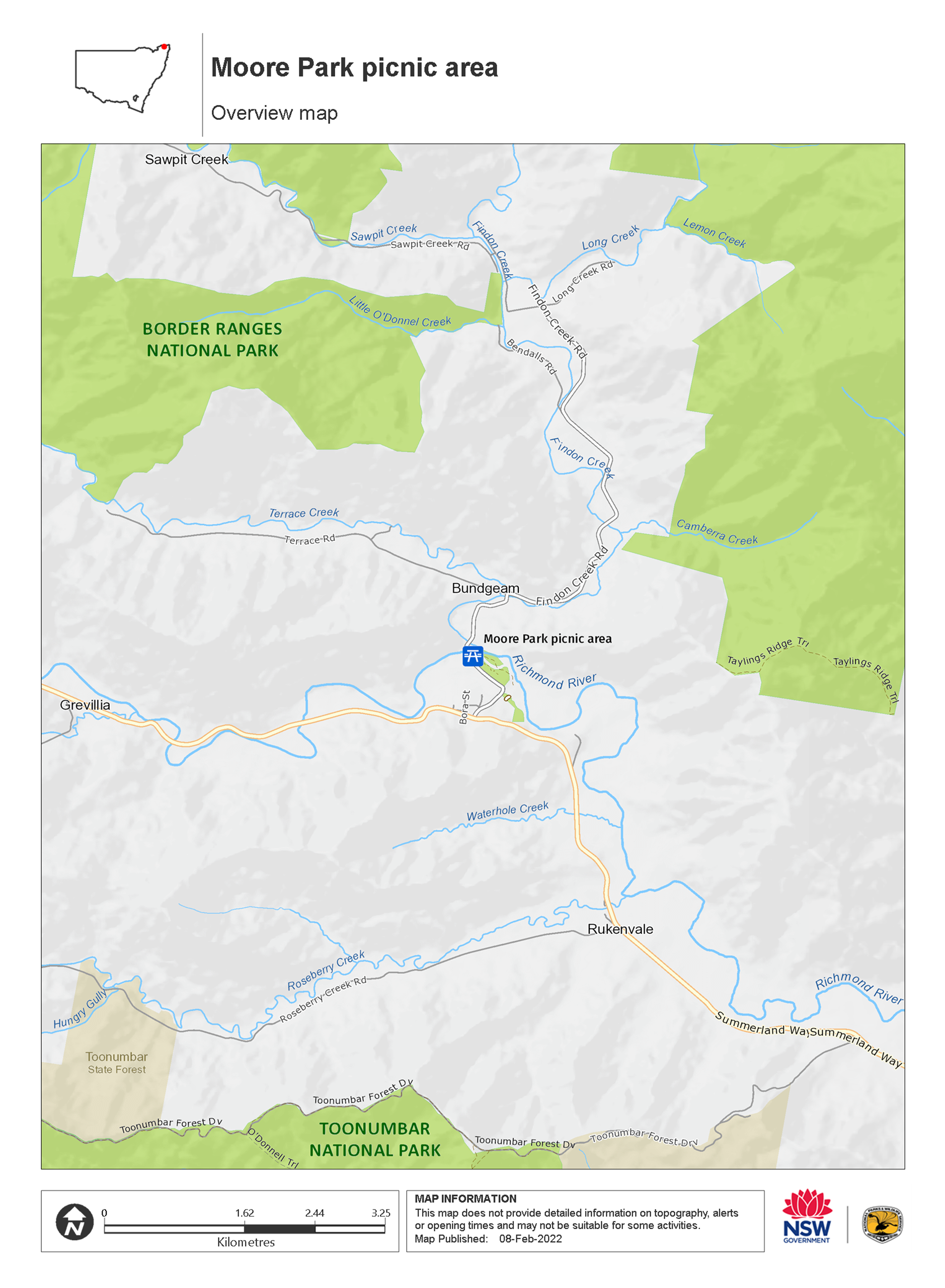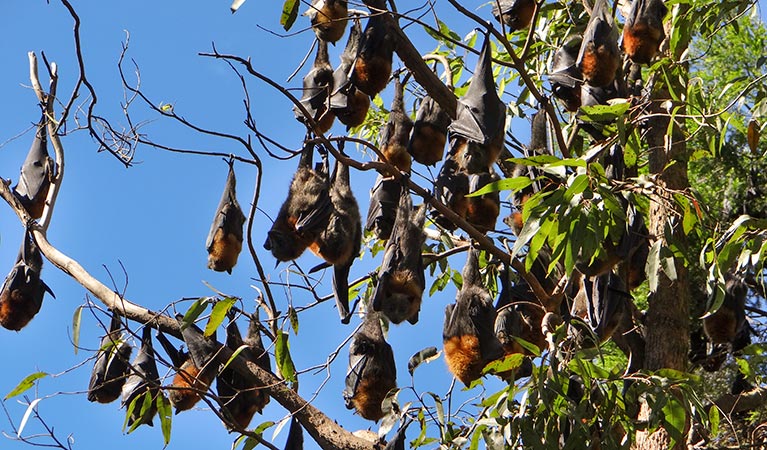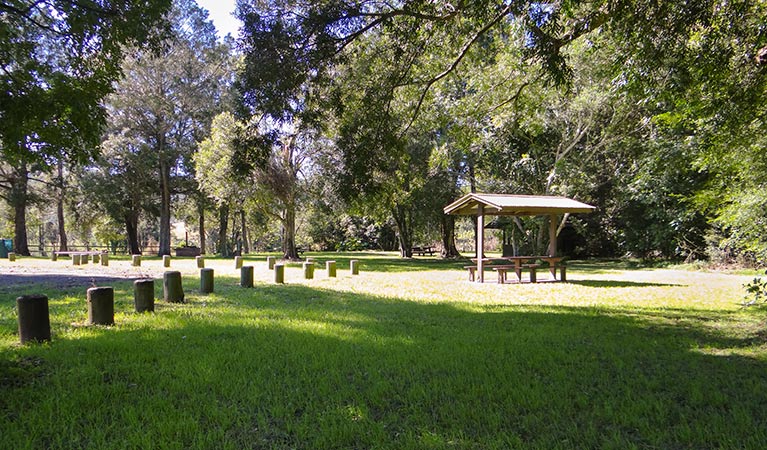Moore Park picnic area
Moore Park Nature Reserve
Overview
Moore Park picnic area offers basic facilities for a leisurely lunch, with terrific opportunities for birdwatching and viewing the large flying fox population.
- Type
- Picnic areas
- Where
- Moore Park Nature Reserve in North Coast
- Accessibility
- Medium
- What to
bring - Drinking water, hat, sunscreen
- Please note
- Please avoid any disturbance to the flying fox camp while it’s occupied
- Remember to take your binoculars if you want to go bird watching
Moore Park picnic area, at the north end of Moore Park Reserve, is the best place to start any visit to the area. Pack a barbecue lunch and settle down around some tables in the cool shade of the rainforest.
Moore Park Nature Reserve is the largest and best remaining example of lowland subtropical rainforest in the entire state, with 127 native plant species showing what the region looked like before widespread logging across the NSW Northern Rivers region in the last century. This makes it a superb place to escape from the hustle and bustle of modern life to the tranquil solitude of nature.
The picnic area is surrounded by beautiful scenery at the junction of Findon Creek and Richmond River. You might notice the high ridges of McPherson Range and Border Ranges National Park. Richmond Range begins to rise to the west and south.
Birdwatchers in particular will find much to occupy their attention here. Rainforest pigeons are often seen in the area, as well as black bitterns, bush hens, and the rose-crowned fruit dove. The grey-headed flying fox dominates the reserve for up to eight months a year. Massing together, they make a dramatic spectacle, but be careful not to disturb their camp when it’s occupied.
Map

Map legend

Local alerts
For the latest updates on fires, closures and other alerts in this area, see https://uat.nswparks.cloud/things-to-do/picnic-areas/moore-park-picnic-area/local-alerts
General enquiries
- National Parks Contact Centre
- 7am to 7pm daily
- 1300 072 757 (13000 PARKS) for the cost of a local call within Australia excluding mobiles
- parks.info@environment.nsw.gov.au
Park info
- in Moore Park Nature Reserve in the North Coast region
Moore Park Nature Reserve is always open but may have to close at times due to poor weather, flooding or fire danger.
Visitor info
All the practical information you need to know about the Moore Park picnic area.
Maps and downloads
Learn more
Moore Park picnic area is in Moore Park Nature Reserve. Here are just some of the reasons why this park is special:
First inhabitants

This region of northern NSW is the home of the Githabul Aboriginal people, for whom the rainforest was an extremely important source of food. There are several known sacred sites in the Northern Rivers area.
Flying high

Moore Park Nature Reserve is also a well-known birdwatching area, with species including the tiny varied sittella (also called nuthatches), rose-crowned fruit dove, the barred cuckoo-shrike and the ground-dwelling bush hen. The reserve is also an essential habitat for winged mammals, with both grey-headed flying foxes and endangered black flying foxes raising their young in a canopy nursery from October to May.
- Moore Park picnic area Moore Park picnic area offers basic facilities for a leisurely lunch, with terrific opportunities for birdwatching and viewing the large flying fox population.
Fragile forest

Much of the landscape around here would have resembled that of Moore Park Nature Reserve before extensive logging and clearing took place during the 20th century. Now, this 14-hectare reserve represents one of the last remnants of the once much-larger Boyd's Scrub, the most important example of black bean rainforest in the state. Robert J Moore, who was the Kyogle Shire Council president from 1920 to 1936, played a leading role in the council's purchase of what remained of Boyd's Scrub and the reserve is now named in his honour.
- Moore Park picnic area Moore Park picnic area offers basic facilities for a leisurely lunch, with terrific opportunities for birdwatching and viewing the large flying fox population.
Meeting spot

Even before this park was created in 1989, it was an important place for the local community, who have enjoyed its serenity and scenery for decades. Many families would gather here and hold functions in what is now the picnic area beside the Richmond River. The area remains a popular destination for picnics and bird watching.
- Moore Park picnic area Moore Park picnic area offers basic facilities for a leisurely lunch, with terrific opportunities for birdwatching and viewing the large flying fox population.

